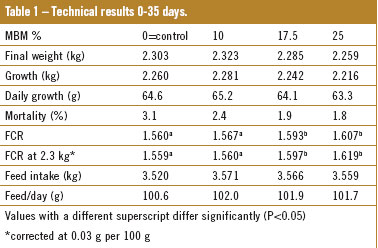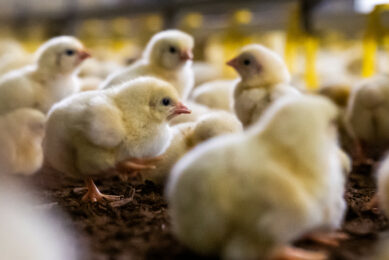Pig MBM in broiler feed did not meet expectations

Wageningen UR Livestock Research studied the effect of the inclusion of MBM in broiler diets on performance, litter quality and external quality. Although it was expected that this would benefit performance and litter quality, the results of this study show that MBM could not live up to presumed expectations.
Since animal proteins are not allowed in feeds any more many problems in the broiler sector, such as dysbacteriosis, wet droppings and increased use of antibiotics, have been attributed to this ban. To get more clarity on the effects of animal proteins in broiler feeds, the Dutch Product board for Poultry and Eggs (PPE), commissioned by the Dutch broiler sector, asked Wageningen UR Livestock Research to carry out an investigation on the results of adding pig meat and bone meal (MBM) in feeds for broilers. Animal protein is a welcome addition to the current used proteinaceous raw materials. The use of animal protein increases the choice in protein supplying raw materials when composing diets. This can possibly lead to decreasing the cost of a formulation. Animal protein is high-value protein. The amino acid profile reflects the needs of an animal better compared to soybean meal. When used, less soybean meal is needed and this decreases the content of potassium in the diet. Lower potassium content can attribute to drier litter, although this was not confirmed in this study. When less soybean meal is used, the demand for soybeans will decrease and saves the tropical forests (because fewer soybeans need to be planted).
Also the use of synthetic amino acids can decrease when animal proteins are used. And the use of MBM in compound feed will lead to lower phosphate excretion, because organic phosphor from animal sources has a better digestibility than phosphor from plant origin or from inorganic sources.
Research set up
At the end of 2009 a trial was setup with 300 male and 360 female day-old chicks (Ross 308). The trial ran from 0-35 days and was carried out in one section of the mechanical ventilated broiler house of poultry research centre ‘Het Spelderholt’ in Lelystad. In the trial the following treatments were compared: Feed without pig MBM (control) and three feeds containing 10%, 17.5% and 25% crude protein from pig MBM respectively, which was achieved by mixing 3, 5.5 and 8% pig MBM in the feed respectively. The pig MBM was exchanged with soybean meal and potato protein. The broilers were housed in 24 floor pens (1.5m2 each). Every pen contained 25 male or 30 female chicks. Treatments were randomly divided among the pens. Every treatment thus had six repeats. The birds were fed ad lib during the whole trial of 35 days.
No improved performance
The use of pig MBM in broiler feed had no effect on growth, feed intake and mortality (Table 1). When more than 10% of the crude protein from MBM was used the feed conversion rate (FCR) decreased. This decrease is possibly caused by relative shortage in valine and isoleucine. The experiment was conducted with only one type of pork meat meal and diets with high MBM inclusion levels were not adjusted for lower valine and isoleucine which may have resulted in adverse performance results at high inclusion levels of MBM. In the two feeds with the highest MBM-content, the calculated content of digestible valine and isoleucine were lower than in the control diet, partly limiting performance. It is known that a shortage of the amino acids in the feed can lead to reduced growth, poorer FCR and lower percentage breast meat. It needs to be noted that the study was carried out under good health and management conditions.
Equal litter quality
The use of pig MBM in broiler feeds did not result in better litter quality and fewer skin lesions. This is in contrast to a study by De Baere and Zoons (2003) who stated that the use of animal protein resulted in drier litter and fewer skin lesions.
What is remarkable is the finding of more serious footpad lesions in birds that received feeds with the two highest MBM contents (Table 2). Although there were no significant differences in dry matter content of the litter, the skin of the breasts were dirtier in birds that received the MBM feeds. This, however, did not result in more skin lesions. In contrast, there was a tendency that birds fed MBM diets had fewer and less serious skin lesions. The use of MBM in the diet had no effect on the occurrence and severity of hock dermatitis.
In conclusion
In general it can be concluded from this research that exchanging 10% of the crude protein in broiler feed with pig MBM had no effect on the technical results. Exchanging a higher percentage of the plant protein with animal protein in this trial gave a poorer performance outcome and more footpad lesions. However, the experiment was conducted with one variety of pork meat meal and diets with high MBM inclusion levels were not adjusted for lower valine and isoleucine which may have resulted in adverse performance results at high inclusion levels of MBM.











